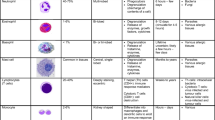Abstract
In vitro preparation of DNA/anti-DNA immune complex using monoclonal antibody and low molecular weight homogeneous DNA was described and the characteristics of the immune complex were identified. The immune complex was formed by the monoclonal antibody with DNA effectively at high ratios of antibody/DNA. The activation and binding ability of the immune complex to the complement was considerably high, whereas the capacity to bind red blood cells via C3b complement component receptor was shown relatively low. The assay of sucrose density gradient ultracentrifugation indicated that the sedimentation coefficient of the immune complex was between 10S and 23S. Studies of organ distribution and uptake of IC demonstrated a particular affinity to the kidney tissue. The significance of these results with respect to the latent pathogenicity of the immune complex was discussed.
Similar content being viewed by others
References
Agnello V and Mitamura T (1982) Evidence for detection of low molecular weight DNA-anti-DNA complexes in systemic lupus erythematosus. Arthritis Rheum 25: 788–792.
Bruneau CD, Edmonds JP, Hughes GRV and Aarden L (1977) Detection and characterization of DNA/anti-DNA complexes in a patient with systemic lupus erythematosus. Clin exp Immun 28: 433–436.
Chng HH, Fock KM, Chew CN, Guan R, Feng PH, Boey ML, Chee EN and Chua KL (1993) Hepatitis B virus infection in patients with systemic lupus erythematosus. Singapore Med J 34: 325–326.
Cornacoff JB, Hebert LA, Smead WL, Van Aman ME, Birminghan DJ and Waxman FJ (1883) Primate erythrocyte-immune complex-clearing mechanism. J clin Invest 71: 236–247.
Davies KA, Hird V, Stewart S, Sivolapenko GB, Jose P, Epenetos AA and Walport MJ (1990) A study of in vivo immune complex formation and clearance in man. J Immunol 144: 4613–4620.
Emlen W and Burdick F (1985) Clearance of Model DNA-anti-DNA immune complexes in mice. Arthritis Rheum 28: S40.
Emlen W, Carl V and Burdick G (1992) Mechanism of transfer of immune complexes from red blood cell CR1 to monocytes. Clin exp Immun 89: 8–17.
Finbloom DS and Plotz PH (1979) Studies of reticuloendothelial function in the mouse with model immune complexes. II. Serum clearance, tissue uptake, and reticuloendothelial saturation in NZB/W mice. J Immun 123: 1600–1603.
Horgan C and Emlen W (1987) Complement fixation by small, DNase-resistant DNA-anti-DNA immune complexes. Molec Immunol 24(2): 109–116.
Horgan C and Taylor RP (1984) Quantitative analyses of complement fixation in three immune complex systems. Immunology 52: 753–759.
Ikebe K, Gupta RC and Tan EM (1983) Characterization of DNA in polyethylene glycol precipitated immune complexes from serum of patients with systemic lupus erythematosus. Clin exp Immun 54: 169–177.
Koffler D, Schur PH and Kunkel HG (1967) Immunological studies concerning the nephritis of systemic lupus erythematosus. J exp Med 216: 607–611.
Koyama A, Kobayashi M, Suzuki S, Suzuki M, Yamaguchi N and Narita M (1991) Detection of DNA-bound immunoglobulins in patients with lupus nephritis, using monoclonal anti-DNA antibody. Clin exp Immun 85: 246–253.
Lennek R, Baldwin AS Jr, Waller SJ, Morley KW and Toylor RP (1981) Studies in the physical biochemistry and complement fixing properties of DNA/anti-DNA immune complexes. J Immun 127: 602–608.
Lu I, Cohen PR and Grossman ME (1995) Multiple dermatofibromas in a woman with HIV infection and systemic lupus erythematosus. J Amer Acad Dermatol 32: 901–903.
Mohan C and Datta SK (1995) Lupus: key pathogenic mechanisms and contributing factors. Clin Immuno Immunopatho 77: 209–220.
Morioka T, Fujigaki Y, Batsford SR, Woitas R, Oite T, Shimizu F and Vogt A (1996) Anti-DNA antibody derived from a systemic lupus erythematosus (SLE) patient forms histone-DNA-anti-DNA complexes that bind to rat glomeruli in vivo. Clin Exp Immun 104: 92–96.
Negoro N, Inoue T, Okamura M, Amatsu K, Curd JG and Kanayama Y (1985) Direct measurement of plasma iC3b-neoantigen level in lupus nephritis by radioimmunoassay. Arthritis Rheum 28: S63.
Pereira AB, Theofilopoulos AN and Dixon FJ (1980) Detection and partial characterization of circulating immune complexes with solid-phase anti-C3. J Immun 125: 763–770.
Raptis L and Menard HA, (1980) Quantitaion and characterization of plasma DNA in normals and patients with systemic lupus erythematosus. J Clin Invest 66: 1391–1399.
Riley RL, Addis DJ and Taylor, RP (1980) Stability of DNA/anti-DNA complexes. II. Salt lability and avidity. J Immunol 124: 1–7.
Sagawa A, (1989) Significance of immunoadsorption therapy in patients with systemic lupus erythematosus. Therapeutic Plasmaphersis (VIII) 93–96.
Takahashi K, Yoshinoya S, Yoshizawa H and Miyamoto T (1987) Extracorporeal hydrophobic amino acid adsorbent therapy in rheumatoid arthritis. Clin Rheumatol 6: 553–563.
Taylor RP, Waller SJ, Haden C and Addis DJ (1980) Stability of DNA/anti-DNA complexes. III. Kinetic control of immune complex size. J Immun 124: 2571–2577.
Terman DS, Stewart I, Robinette J, Carr R and Harbeck R (1976) Specific removal of DNA antibodies in vivo with an extracorporeal immuno-absorbent. Clin Exp Immun 24: 231–237.
Rights and permissions
About this article
Cite this article
Gao, Y., Wang, P., Tajima, A. et al. Physical and biological studies on DNA/anti-DNA immune complex formed in vitro. Cytotechnology 25, 165–171 (1997). https://doi.org/10.1023/A:1007926809023
Issue Date:
DOI: https://doi.org/10.1023/A:1007926809023




